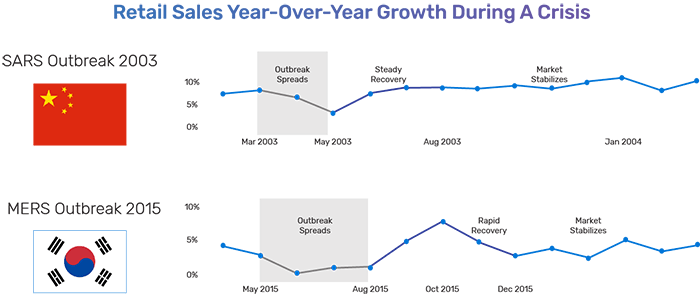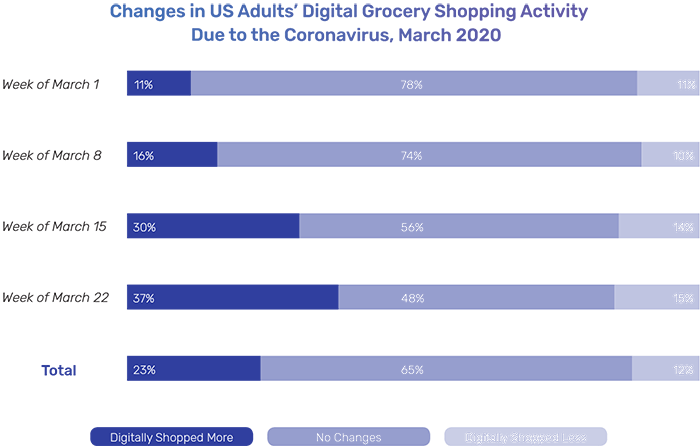We can’t ignore today’s unprecedented landscape — millions of businesses are shuttered, and demand has softened as global unemployment has skyrocketed. Ocean freighters are lessening traffic as production grinds to a halt. Air cargo is being supplemented by the passenger air industry as their revenue disappears from consumer and business travel.
These bleak realities are all true and a bit frightening. Despite these facts, there are other realities to consider that lend to optimism. Testing for the virus is also skyrocketing. The pharmaceutical industry is collaborating globally on treatments and vaccines for the virus in a manner of collaboration the world has not seen since the Polio crisis. Private sector companies are re-tooling for ventilator and PPE production. For these reasons, there may be cause to look to a future after COVID-19 and prepare for the massive opportunities for businesses that position themselves to capture these opportunities. The world can see how interconnected people are at a time like this, and staying connected will lead to both a health recovery and economic recovery.
Retail Sales Year-Over-Year Growth During A Crisis

Shifting to Online Everything
During this time of sheltering indoors, some segments of ecommerce have experienced record growth due to online ordering being the only way to source necessary goods for daily life. Older consumers who resisted ordering online have suddenly been forced to and are becoming more comfortable with ordering food, medicine, household goods, and more to be delivered. Studies are suggesting that ordering online will become a habit even after shelter-in- place mandates are lifted.

Online shopping can be automated, can drive down the cost of goods, and can expose consumers to new and exciting options. In fact, the whole internet is becoming the everything store. You can access it at any time, from anywhere, for any reason.
Fulfilling the Global Demand
No two countries are the same in terms of how they are impacted by the virus and how they will recover. This variance in recovery opens the opportunity for a company that is able to ship to any country whose economy is barely impacted or countries that recover faster in order to fulfill the demand in that country. The ability to quickly export goods where there is demand ensures that a company will be able to continue to sell goods, even when their competitors and peers that are geo-located close by will essentially be shuttered.
A company’s ability to be nimble and to export intelligently may be a factor that makes or breaks entire industries. The opportunity for outsourcing is most obvious for essential goods whose demand in ecommerce is currently elevated but extend into high-demand, non- essential goods that may not be available in a given country. Businesses of all sizes can adopt a few simple measures to ensure that they can source, sell, and ship goods all over the world. Savvy businesses must first understand where demand is spiking or may spike in the near future in order to plan for a country-specific cross-border strategy. CCI is tracking the week-over-week changes in global demand for both Online Retail and Pure Play Ecommerce.
In the coming decade, it’s going to be easier than ever to be a global business from anywhere in the world. As supply and cross- border continue to get easier, ecommerce demand will continue to soar.
Shifts in Buying and Sourcing Behavior
Before the COVID-19 crisis, 21.8% of the population worldwide already shopped online. Retail ecommerce sales worldwide are expected to reach $4.8 trillion by 2021. It’s more important than ever to think about how you can serve customers wherever they’re located. Many business owners avoid shipping overseas due to the “perceived” complexity. Businesses are struggling right now, it may be time to open up the opportunity to consider a cross-border strategy to mitigate the risk of slowing demand in their local area.
Another business aspect to consider is the product sourcing strategy. Coronavirus halted Asian imports and may lead companies to diversify their sourcing and manufacturing. Many companies across verticals will source more from South America and Canada. Some might even bring all of their manufacturing in- house back to the US.
The true impact this crisis will have on sourcing will not be clear until well after 2030. However, the most obvious impact is the need to diversify. It’s become increasingly obvious that the ability to change where products are sourced, what products are offered, and where products are sold and shipped to, can be the difference between thriving or shuttering as a company.
These months are a great time to analyze which countries are less affected by the virus and seek out relationships for sourcing goods that will be in global demand. Evaluating where the market will be is a gargantuan task, which is why dropshipping websites and sourcing aggregators are helpful in identifying potential vendor partners. Some companies are experimenting with putting products on sale first with the expectation of 1+ month delivery to provide pre-orders as a confidence point to new manufacturers.
By the year 2040, as much as 95% of shopping will be facilitated by ecommerce.
Selling to New Markets
With their product in hand, companies need to prepare to sell a product to overseas markets. This can be done without tackling translation — as English can reach much of the world — but does require thought about accepting different currencies, complying with taxes, and understanding legal, data, and privacy restrictions.
Seemingly, the greatest challenge of cross- border is shipping. Companies must accurately pass customs information and wrangle specific regulations for more sensitive products (hazmat, CBD, live animals, etc). Additionally, customers need to set up shipping accounts with carriers that support the regions they sell to. The USPS’s partner network for international, along with DHL, have shown to be strong options for shipping to most of the developed world. Once rates are established, products need to be accurately categorized, and customs forms and labels must be applied to be exported. Finally, companies need to find solutions for covering the duties and taxes on a country-by-country basis.
The beauty of exploding ecommerce is that a lot of these complexities have been tackled by numerous platforms and APIs that provide all or part of these needs and enable companies of all sizes to take advantage of the cross-border opportunity. Prioritize selecting software partners that provide international shipping capabilities and that can integrate and work well together — with the ERP or the ecommerce platform as the center of business management. Some ecommerce platforms may cover all the features that a small business would need to source, sell, and ship internationally. APIs and software platforms provide the components for small businesses and enterprises to scale and cover all of the complexity at higher volumes. Don’t miss the next wave of global commerce — prepare your business at any size to sell to any part of the world that is and will be eager to buy.
The What
Essential goods, entertainment, and work- supporting goods are currently in high demand. Beauty, travel, and luxury are currently in decline but may rebound as pent up demand comes to light when the virus is contained. Any goods with rising demand before the virus outbreak will likely see increases during or at least after.
The Why
Cross-border trade will continue to get easier as more software platforms and international trade agreements are formed for the good of all global citizens. The top ecommerce, inventory management, and dropshipping platforms have already begun to make cross-border trade possible for businesses of any size.
The How
Cross-border sales are critical for diversifying your customer base when local purchases are in decline, but demand is spiking abroad. Companies that can fulfill demands by country will win when other companies who only sell locally are decimated.
Life After COVID-19: Cross Border Commerce for Faster Economic Recovery for US Businesses is an excerpt from our white paper, The Future of Shopping. Get the full report in your inbox and discover 7 emerging trends in ecommerce.


